
Freikorps were irregular German and other European military volunteer units, or paramilitary, that existed from the 18th to the early 20th centuries. They effectively fought as mercenaries or private military companies, regardless of their own nationality. In German-speaking countries, the first so-called Freikorps were formed in the 18th century from native volunteers, enemy renegades, and deserters. These sometimes exotically equipped units served as infantry and cavalry ; sometimes in just company strength and sometimes in formations of up to several thousand strong. There were also various mixed formations or legions. The Prussian von Kleist Freikorps included infantry, jäger, dragoons and hussars. The French Volontaires de Saxe combined uhlans and dragoons.

Baltic Germans are ethnic German inhabitants of the eastern shores of the Baltic Sea, in what today are Estonia and Latvia. Since their resettlement in 1945 after the end of World War II, Baltic Germans have markedly declined as a geographically determined ethnic group in the region.

The United Baltic Duchy, or alternatively the Grand Duchy of Livonia, was the name of a short-lived state during World War I that was proclaimed by leaders of the local Baltic German nobility.

The Estonian War of Independence, also known as the Estonian Liberation War, was a defensive campaign of the Estonian Army and its allies, most notably the United Kingdom, against the Soviet Russian westward offensive of 1918–1919 and the 1919 aggression of the pro–German Baltische Landeswehr. The campaign was the struggle of the newly established democratic nation of Estonia for independence in the aftermath of World War I. It resulted in a victory for Estonia and was concluded in the 1920 Treaty of Tartu.

Albert Leo Schlageter was a German military officer who joined a right-wing Freikorps group after World War I and became famous for acts of post-war sabotage against French occupational forces. Schlageter was arrested for sabotaging a section of railroad track and executed by the French military. The manner of his death fostered an aura of martyrdom around him, which was cultivated by German nationalist groups, in particular the Nazi Party. In Nazi Germany, he was commemorated as a national hero.

The Latvian Riflemen were originally a military formation of the Imperial Russian Army assembled starting 1915 in Latvia in order to defend Baltic governorates against the German Empire in World War I. Initially, the battalions were formed by volunteers, and from 1916 by conscription among the Latvian population. A total of about 40,000 troops were drafted into the Latvian Riflemen Division. They were used as an elite force in the Imperial and Red armies.

The Lithuanian Wars of Independence, also known as the Freedom Struggles, refer to three wars Lithuania fought defending its independence at the end of World War I: with Bolshevik forces, Bermontians, and Poland. The wars delayed international recognition of independent Lithuania and the formation of civil institutions.

Gustav Adolf Joachim Rüdiger Graf von der Goltz was a German army general during the First World War. He commanded the Baltic Sea Division, which successfully intervened in the Finnish Civil War in the spring of 1918. Goltz stayed with his troops in Finland until December 1918 representing German interests, and in practice ruled the country as a military dictator during this period. After the Armistice of 11 November 1918, Goltz commanded the army of the local German-established government of Latvia, which in 1919 was instrumental in the defeat of the Russian Bolsheviks and their local allies in Latvia. The troops commanded by Goltz suffered a defeat against Estonia in 1919 and were eventually unsuccessful in retaining German control over Latvia and Estonia after World War I.
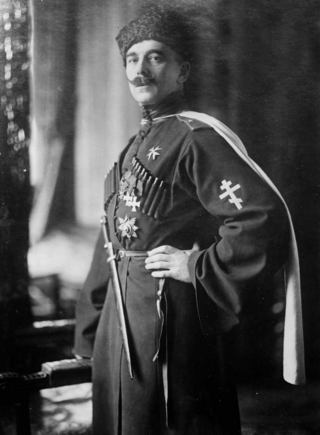
Prince Pavel Rafailovich Bermondt-Avalov or Prince Avalov was a Russian Imperial officer and a Cossack adventurer-warlord. He is best known as the commander of the West Russian Volunteer Army which was active in present-day Latvia and Lithuania in the aftermath of World War I.
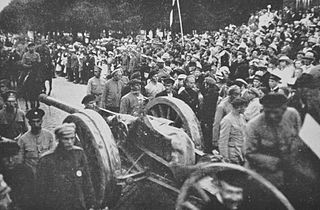
The Latvian War of Independence, sometimes called Latvia's freedom battles or the Latvian War of Liberation, was a series of military conflicts in Latvia between 5 December 1918, after the newly proclaimed Republic of Latvia was invaded by Soviet Russia, and the signing of the Latvian-Soviet Riga Peace Treaty on 11 August 1920.

Baltic German nobility was a privileged social class in the territories of today's Estonia and Latvia. It has existed continuously since the Northern Crusades and the medieval foundation of Terra Mariana. Most of the nobility were Baltic Germans, but with the changing political landscape over the centuries, Polish, Swedish and Russian families also became part of the nobility, just as Baltic German families re-settled in locations such as the Swedish and Russian Empires. The nobility of Lithuania is for historical, social and ethnic reasons separated from the German-dominated nobility of Estonia and Latvia.

After 1918, the term Freikorps was used for the anti-communist paramilitary organizations that sprang up around the German Empire and the Baltics, as soldiers returned in defeat from World War I. It was one of the many Weimar paramilitary groups active during that time.

The Baltic Landwehr or Baltische Landeswehr was the name of the unified armed forces of Couronian and Livonian nobility from 7 December 1918 to 3 July 1919.
The Battle of Cēsis, fought near Cēsis in June 1919, was a decisive battle in the Estonian War of Independence and the Latvian War of Independence. After heavy fighting an Estonian force moving from the north, supplemented by Latvian units, repelled Baltic German attacks and went on full counter-attack.

Lāčplēsis Day is a memorial day for soldiers who fought for the independence of Latvia. It is celebrated on November 11th, marking the decisive victory by the Latvian Army over the joint Russian-German West Russian Volunteer Army led by the warlord Pavel Bermondt-Avalov at the 1919 Battle of Riga during the Latvian War of Independence, thus safeguarding the independence of the nascent nation. It initially was a day of honoring the 743 soldiers that fell in the battles around the Riga area.
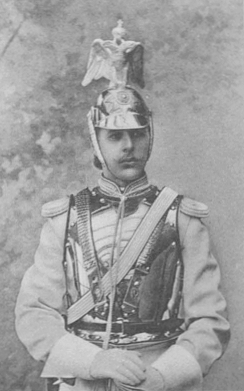
Anatol Leonid Fürst von Lieven was a Russian military commander from the Baltic German princely house of Lieven. During the Russian Civil War he commanded a White force in Latvia known after him as the Liventsy.
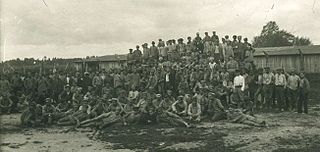
The Lithuanian–Soviet War or Lithuanian–Bolshevik War was fought between newly independent Lithuania and the Russian Socialist Federative Soviet Republic in the aftermath of World War I. It was part of the larger Soviet westward offensive of 1918–1919. The offensive followed the retreat of German troops and sought to establish Soviet republics in Ukraine, Belarus, Lithuania, Latvia, Estonia, Poland and link up with the German Revolution. By the end of December 1918 Soviet forces reached Lithuanian borders. Largely unopposed, they occupied one town after another and by the end of January 1919 controlled about two thirds of the Lithuanian territory. In February, the Soviet advance was stopped by Lithuanian and German volunteers, who prevented the Soviets from capturing Kaunas, the temporary capital of Lithuania. From April 1919, the Lithuanian war went parallel with the Polish–Soviet War. Poland had territorial claims over Lithuania, especially the Vilnius Region; these tensions spilt over into the Polish–Lithuanian War.

Henri Albert Niessel was a French general.

The Battle of Jelgava was an operation of the Latvian Army from 15 to 21 November 1919 during the Latvian War of Independence. The Latvian Army forced the units of the Western Russian Volunteer army subordinated to the Weimar Republic to leave Jelgava. Because of this attack, the German Government's intention to start ceasefire talks and reach agreement on the further political status of Courland and Zemgale with Latvian Provisional Government failed.
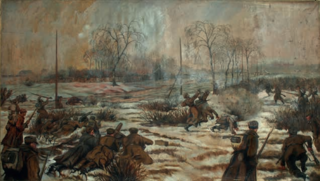
The Battle of Radviliškis was fought between the Lithuanian Armed Forces and the Western Russian Volunteer Army, also known as Bermontians, a pro-German military formation, commanded by Pavel Bermondt-Avalov near the city of Radviliškis as part of the Lithuanian Wars of Independence. Fought on 21–22 November 1919, it saw the decisive defeat of the Bermontians and their subsequent retreat from the Baltic States.





















